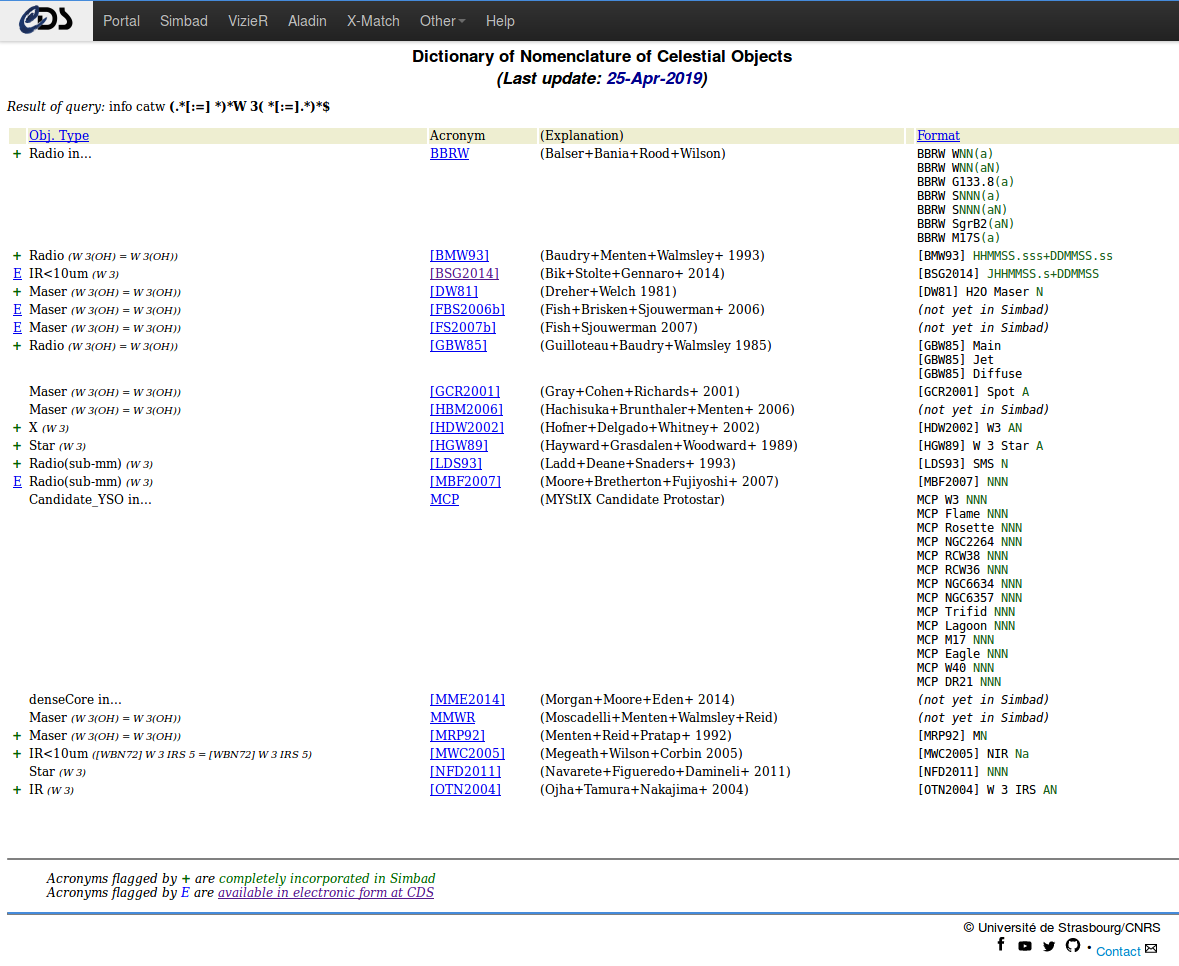Helpful Hints:
Current Practices regarding subcomponents
The designation of subcomponents of a source still presents problems and a satisfactory solution is being sought. In the meantime, several approaches have been tried. These are described below with their advantages and disadvantages. In addition, some suggestions are provided to help you locate the reference and/or the subcomponent (object on the sky).
In practice, the inclusion of the parent source in the designation of the subcomponent is needed when the designation would otherwise be ambiguous, as in the case of IRS 3 which might refer to NGC 7538 IRS 3, to W 3 IRS 3, etc.
Contents
1. Descriptive designations
Descriptive designations are made of just letters or numbers, relative directions, or combinations thereof, or sickle, eagle, column I, arc, streamer, jet... Here are a few examples:
- W 3 C, W 3 IRS 5,
W 3 (OH), DR 21:CO 1,
W 49 A, Sgr B2
where the larger (parent) sources are radio sources
W 3, DR 21,
W 49, and Sgr B.
- Sgr B2 Main, Sgr B2 North,
W 49 A North,
- W 49 A North:G, W 49 A North:G1 where these examples show the division into additional subcomponents and the (optional) use of : to help delineate the hierarchical nature.
Advantage - within the context of the particular paper which names the components, these descriptive or simple subcomponent designations are quite clear and useful.
Disadvantages - however, the same object may receive a different letter designation by two different authors studying the region at different wavelengths; similarly the same letter may be used to designate different components within the same source. In addition, it is often difficult to find the reference to the subcomponent at a later date.
2. Creating Acronyms
Use of one of the methods of Creating Acronyms for subcomponents just as is done for sources themselves - e.g. just an acronym and a number such as ASR 122 (where ASR refers to the authors Aspin+Sandell+Russell). Then, in the text, one just indicates that these are subcomponents of a particular source, NGC 1333 in this example. Alternatively one can include the parent source in the designation - e.g. NGC 1333:ASR 122.The advantage of this technique is that later researchers can easily find the reference for ASR 122 by searching for ASR in the Interactive Dictionary of Acronyms.
The disadvantage is that ASR 122 does not convey any information about the nature of the subcomponent (you have to look up the reference).
3. Ways of finding a subcomponent
The methods are very dependent from the database. Some examples are shown.
- NED has some
easy ways to find subcomponents.
- You just give the name of the parent object: e.g. ARP 229 gives you NGC 0507 (= ARP 229 NED01) and NGC 0508 (=ARP 229 NED02), e.g. with 3C 295 NED gives a list of 216 subcomponents of 3C 295. However, you have to give the exact name of the parent. If you give 4C +52.30 (= 3C 295), you obtain only one object.
- The same architecture could give you access to the parent
object: e.g. NGC 507 shows you, looking the
different cross-id, that this galaxy is a subcomponent of
ARP 229, LGG 026 and RX J0123.6+3315.
These methods are based on the structure of the designation. - The search by coordinates gives you also access to some components.
Within NED subcomponents generally contain the host object as the leading part of the name. The structure is "root_name" ":" "[abdyyyy]" "ID" (all without the quotes). The "root_name" is one of the cross-identifications of the host object, the colon, :, is used as a separator, the characters within square brackets contains the first letters of the first three authors last names followed by the year of publication, and, finally, the "ID" is the designation given to the object by the authors. The "root_name" is either the name of the host given by the authors or a more consistent name used in NED.
Subcomponents can be found in NED by using the "BY NAME" search option and supplying the host name. This name is "wildcarded" and all objects with the host name as a prefix are retrieved. This wildcarding can also be turned off so the user gets ONLY the host information, if desired.
- SIMBAD
has some similar methods.
- For some objects, the root of a name gives you access to the components, e.g. CCDM J00028+8017 gives you CCDM J00028+8017A and CCDM J00028+8017B.
- An identifier query allows you to use wildcards.
- The search by coordinates gives you also access to some components.
- The Interactive Dictionary of Acronyms
To search for possible subcomponents of a source (and find the relevant references), one can use the Interactive Dictionary of Acronyms and under "Choose one of the query options: ", select "included in object", and then under "Type in your words" put the name of the object.
If the parent object is essential for locating a source such as IRS sources (W 3 IRS 5, NGC 7538 IRS 5, etc.) then you may find both the parent source and subcomponents listed. If it is not essential, then you will not. For example, for parent object W 3 one finds the following components:
